
Basaltic lava flows erupt primarily from shield volcanoes, fissure systems, scoria cones, and spatter cones. These fluid lava flows can be subdivided into two end-member structural types, based primarily on the nature of lava flow surfaces:

|

|

|
|
|
|
|
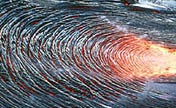 Pahoehoe can take several different forms.
As the smooth lava surface cools to turns to a dark gray color
and becomes less fluid and more viscous, behaving more like a
plastic substance than a truly liquid substance. As lava continues
to flow underneath this plastic skin, the surface can bunch up
or wrinkle into a form that resembles coiled rope. Such a surface
is called ropy pahoehoe. In addition to these ropy
surfaces, solidified basalt flows can also display shelly to slabby
surfaces. Shelly pahoehoe contains a billowy flow
top with a frothy vesicular surface skin, only a few centimeters
thick, overlying large cavities, generally 5-30 centimeters thick.
These shelly surfaces often collapse when walking on the top of
the flow. Slabby pahoehoe contains a series of closely
spaced slabs, a few meters across and a few centimeters thick,
broken and tilted by mass movement, or drainage, of the underlying
lava. Slabby pahoehoe is often gradational to a'a lava.
Pahoehoe can take several different forms.
As the smooth lava surface cools to turns to a dark gray color
and becomes less fluid and more viscous, behaving more like a
plastic substance than a truly liquid substance. As lava continues
to flow underneath this plastic skin, the surface can bunch up
or wrinkle into a form that resembles coiled rope. Such a surface
is called ropy pahoehoe. In addition to these ropy
surfaces, solidified basalt flows can also display shelly to slabby
surfaces. Shelly pahoehoe contains a billowy flow
top with a frothy vesicular surface skin, only a few centimeters
thick, overlying large cavities, generally 5-30 centimeters thick.
These shelly surfaces often collapse when walking on the top of
the flow. Slabby pahoehoe contains a series of closely
spaced slabs, a few meters across and a few centimeters thick,
broken and tilted by mass movement, or drainage, of the underlying
lava. Slabby pahoehoe is often gradational to a'a lava.
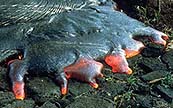 Pahoehoe lavas are typically
the first to erupt from a vent. They are relatively thin (1-2
m) and very fluid with low viscosities. They advance downslope
in a sort of smooth "rolling motion." The front of the
flow usually advances as a thin (< 20 cm) glowing lobe
that will chill and crust over after 1-2 meters of flow. It will
slow and be overrun by a new lobe that propagates downslope until
it also chills, and in turn is overrun by another flow. Overriding
lavas and breakouts on the flow top and sides thus produce compound
flows
composed of
several lobes cooling against one another. Slower moving pahoehoe
flows will advance through the protrusion of small bulbous appendages
at the flow front, called pahoehoe toes. The image above shows
a breakout and the advancement of pahoehoe toes along the sides
of a ropy pahoehoe lava flow. As the lava surface cools
and thin skin becomes more viscous, progressive breakouts will
occur, thus advancing the flow forward, as demonstrated below.
Where pahoehoe toes advance rapidly, usually down steeper slopes,
an elongated protrusions may emerge, called entrail
pahoehoe.
Pahoehoe lavas are typically
the first to erupt from a vent. They are relatively thin (1-2
m) and very fluid with low viscosities. They advance downslope
in a sort of smooth "rolling motion." The front of the
flow usually advances as a thin (< 20 cm) glowing lobe
that will chill and crust over after 1-2 meters of flow. It will
slow and be overrun by a new lobe that propagates downslope until
it also chills, and in turn is overrun by another flow. Overriding
lavas and breakouts on the flow top and sides thus produce compound
flows
composed of
several lobes cooling against one another. Slower moving pahoehoe
flows will advance through the protrusion of small bulbous appendages
at the flow front, called pahoehoe toes. The image above shows
a breakout and the advancement of pahoehoe toes along the sides
of a ropy pahoehoe lava flow. As the lava surface cools
and thin skin becomes more viscous, progressive breakouts will
occur, thus advancing the flow forward, as demonstrated below.
Where pahoehoe toes advance rapidly, usually down steeper slopes,
an elongated protrusions may emerge, called entrail
pahoehoe.
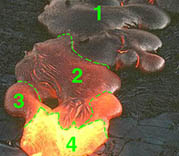
|
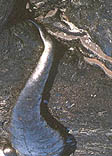
|
|
|
Pahoehoe |
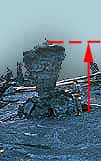 High effusion rates may result in the
development of inflated pahoehoe sheetflows. These
large-volume pahoehoe flows are emplaced initially as thin sheets,
20-30 cm thick. Cooling of these flow sheets will produce a smooth
pahoehoe crust which initially behaves in a plastic fashion. However,
after attaining a thickness of 2-5 cm, the crust behaves more
rigidly and develops strength. As the underlying liquid core of
the flow increases in size due to sustained lava injection, the
hydrostatic head of the flow is distributed evenly throughout.
This can result in flow inflation and uniform uplift of
the entire flow sheet. Such flows will inflate and thicken by
as much as 4 meters. Many of these inflated flows will crystallize
in place; however, some will deflate after emplacement as the
fluid core drains beneath the solidified crust. Deflation is evident
in many Hawaiian flows which contain tree molds that currently
stand 1-2 meters above the current surface of the pahoehoe sheet
flows. An example of deflation on Kilauea Volcano, Hawaii, is demonstrated
to the left by solidified lava around high-standing tree trunks
to produce hollow tree molds standing above the deflated pahoehoe
surface.
High effusion rates may result in the
development of inflated pahoehoe sheetflows. These
large-volume pahoehoe flows are emplaced initially as thin sheets,
20-30 cm thick. Cooling of these flow sheets will produce a smooth
pahoehoe crust which initially behaves in a plastic fashion. However,
after attaining a thickness of 2-5 cm, the crust behaves more
rigidly and develops strength. As the underlying liquid core of
the flow increases in size due to sustained lava injection, the
hydrostatic head of the flow is distributed evenly throughout.
This can result in flow inflation and uniform uplift of
the entire flow sheet. Such flows will inflate and thicken by
as much as 4 meters. Many of these inflated flows will crystallize
in place; however, some will deflate after emplacement as the
fluid core drains beneath the solidified crust. Deflation is evident
in many Hawaiian flows which contain tree molds that currently
stand 1-2 meters above the current surface of the pahoehoe sheet
flows. An example of deflation on Kilauea Volcano, Hawaii, is demonstrated
to the left by solidified lava around high-standing tree trunks
to produce hollow tree molds standing above the deflated pahoehoe
surface.
The a'a flows shown below are advancing over older pahoehoe surfaces. Although these lava flows are often more viscous, and typically thicker, than pahoehoe lavas they tend to advance at greater rates. Their flow fronts can vary from two meters to as much as twenty meters thick. Their forward motion is similar to the movement of a tractor tread. A jumbled mass of debris steepens at the flow front until a section breaks off and tumbles forward. Inward from the flow front, the flow usually contains an upper rubbly flow top, and a lower massive part of viscous lava insulated from the overlying rubble. The jagged cinder blocks that break off the front are then overridden by the massive lava core of the flow which pushes forward.
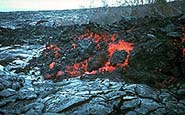
|
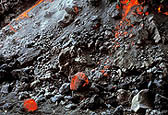
|
|
|
|
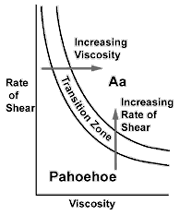
|
Pahoehoe is often converted to a'a as lava advances downslope, away from the volcano. Conversion of a'a to pahoehoe, on the other hand, never takes place. The pahoehoe-to-a'a conversion can be caused by either an increase in flow viscosity, or an increase in the rate of shear. Cooling, gas loss, and crystallization of the lava will cause it to become increasingly more polymerized and viscous as it advances farther downslope. Although the downslope increase in viscosity can convert pahoehoe to a'a, a higher rate of shear can also cause the conversion. Shear increases in flows that have higher effusion rates. A'a begins to form when effusion rates are >5-10 cubic meters per second. The rate of shear can also increase as lava advances down increasingly steeper slopes. This is demonstrated, for example, by the conversion of pahoehoe to a'a in recent lava flows that have advanced down the Hilina Pali escarpment during the ongoing eruption of the Pu'u O'o Volcano, Hawaii. |